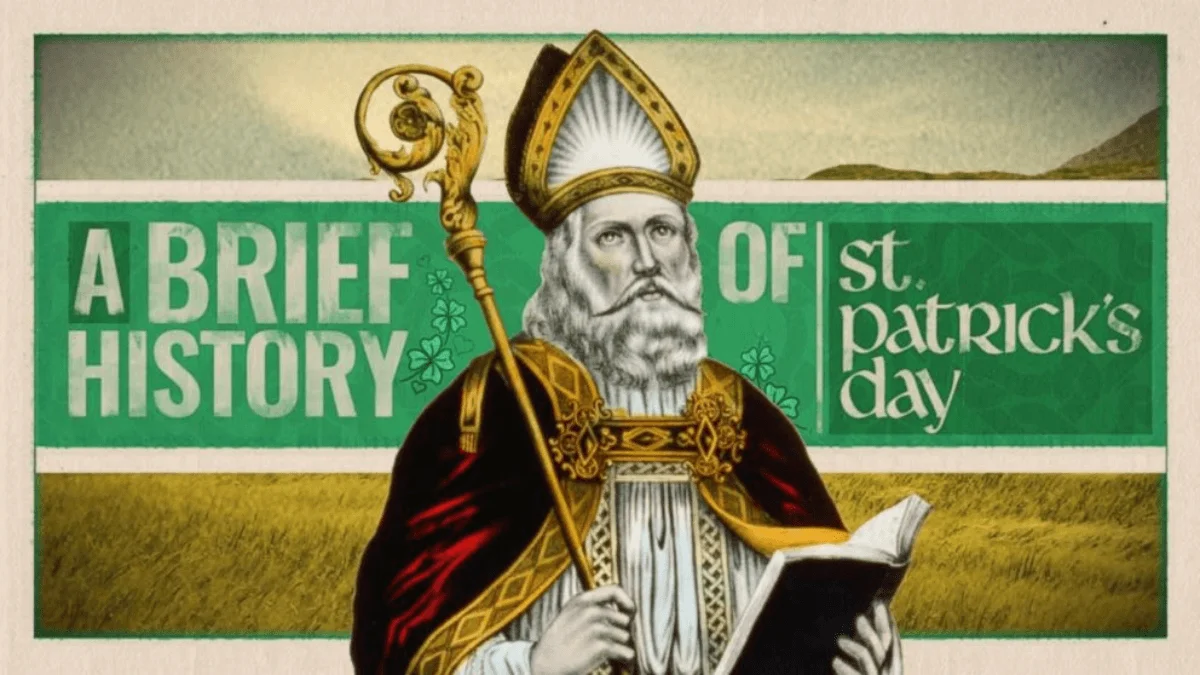Saint Patrick’s Day, celebrated every year on March 17th, is a cultural and religious holiday that honors the life and work of Saint Patrick, the patron saint of Ireland.
It’s a day of celebration where people around the world, regardless of their Irish heritage, participate in parades, wear green attire, and enjoy traditional Irish food and drinks.
Importance of Understanding Its Origins
Understanding the origins of Saint Patrick’s Day is crucial for appreciating the depth and significance of this holiday.
It’s not just about wearing green or participating in parades; it’s about honoring Saint Patrick, who played a pivotal role in Irish history.
By delving into the origins of this day, we can gain a deeper appreciation for the holiday and the rich cultural heritage it represents.
Is Saint Patrick’s Day a Pagan Holiday?

Who was Saint Patrick?
Early Life and Background
Saint Patrick, also known as Patricius, was born in Roman Britain in the late 4th century AD.
His father was a deacon and his grandfather was a priest in the Christian church, which influenced his early religious upbringing.
However, his faith journey truly began when he was kidnapped at the age of 16 by Irish raiders and taken as a slave to Gaelic Ireland.
His Journey to Sainthood
During his six years of captivity, Patrick worked as a shepherd and turned to his faith for solace.
He grew deeply devoted to Christianity and, according to his writings, had a vision that prompted his escape.
He managed to return home and subsequently became a cleric, just like his father and grandfather.
Patrick felt a calling to return to Ireland and convert the Irish to Christianity.
He spent many years evangelizing in the northern and western parts of Ireland and is credited with numerous conversions.
His dedication to his mission, his piety, and his leadership led to his eventual canonization.
His Mission in Ireland
Patrick’s mission in Ireland wasn’t easy. He faced opposition from druidic priests and was even arrested several times.
However, he continued his evangelistic mission, building churches across the country and spreading Christianity throughout Ireland. His work laid the groundwork for Ireland’s enduring Christian tradition.
St. Patrick’s Day Sayings | A Pot of Golden Wisdom
The Mystery: The Death of Saint Patrick
The Origin of Saint Patrick’s Day
The First Celebration of Saint Patrick’s Day
The first recorded celebration of Saint Patrick’s Day took place not in Ireland, but in St. Augustine, Florida, in the year 1600, organized by the Spanish colony’s Irish vicar, Ricardo Artur.
However, the day was only made an official feast day in the early 17th century. It was initially celebrated with religious ceremonies and a reprieve from the restrictions of Lent.
Evolution of the Day Over the Years
Over time, Saint Patrick’s Day has evolved from a religious observance to a celebration of Irish culture.
Parades, wearing of green attire, public festivals, and the lifting of Lenten restrictions on eating and drinking alcohol are now common practices associated with the holiday.
Changes in the Way It’s Celebrated
While the religious aspects of Saint Patrick’s Day are still observed by many, especially in Ireland, the day has taken on a more secular character worldwide.
Parades featuring marching bands, traditional Irish music, and the wearing of green have become integral parts of the celebrations.
Influence of Global Culture
The global spread of Irish culture, particularly through its diaspora, has led to Saint Patrick’s Day being celebrated in many parts of the world.
Today, it’s not just a celebration of Saint Patrick or of Irish heritage, but a celebration of Irish culture and its global influence.
Saint Patrick’s Day in Ireland
Traditional Celebrations and Customs
In Ireland, Saint Patrick’s Day is both a holy day and a national holiday. The day is marked with several customs and traditions:
- Parades: Saint Patrick’s Day parades are held in various towns and cities across Ireland. The largest of these is in Dublin, attracting hundreds of thousands of spectators each year.
- Religious Ceremonies: Many Irish people attend mass on Saint Patrick’s Day to offer prayers and thanks.
- Wearing of Green Attire: It’s customary to wear green clothing or accessories on Saint Patrick’s Day. This tradition is linked to “the wearing of the green”, which involves wearing a shamrock on one’s clothing.
- Feasting: Traditional Irish meals, like corned beef and cabbage, are commonly enjoyed on Saint Patrick’s Day.
Significance in Irish Culture
Role in National Identity
Saint Patrick’s Day plays a significant role in Irish national identity. It’s a day when everyone, whether in Ireland or abroad, can celebrate being Irish and participate in Irish culture.
Impact on Arts and Music
Saint Patrick’s Day has a significant impact on Irish arts and music. Traditional Irish music is a key part of the celebrations, and many events showcase Irish dance, theatre, and visual arts.
Here’s a table summarizing the different ways Saint Patrick’s Day is celebrated in Ireland:
| Tradition | Description |
| Parades | Held in various towns and cities across Ireland, with the largest in Dublin. |
| Religious Ceremonies | Many Irish people attend mass to offer prayers and thanks. |
| Wearing of Green Attire | Customary to wear green clothing or accessories. |
| Feasting | Traditional Irish meals are commonly enjoyed. |
Saint Patrick’s Day Around the World
How the Day is Celebrated in Different Countries
Saint Patrick’s Day is celebrated not just in Ireland, but around the globe.
Here’s a look at how it’s celebrated in different countries:
- United States: Saint Patrick’s Day is widely celebrated across the United States with parades, wearing of green attire, and public festivities. Some cities, like Chicago, even dye their rivers green for the occasion.
- Canada: In Canada, Saint Patrick’s Day is often marked with parades and festivities. Montreal hosts one of the oldest Saint Patrick’s Day parades in North America.
- Australia: In Australia, Saint Patrick’s Day was originally observed with religious ceremonies. Today, it includes parades and festivals that celebrate Irish culture.
Influence of Irish Diaspora
The widespread celebration of Saint Patrick’s Day can be attributed to the influence of the Irish diaspora. Irish immigrants carried their traditions with them, and over time, these traditions were embraced by the wider population.
This has led to Saint Patrick’s Day becoming a global celebration of Irish culture.
Common Misconceptions About Saint Patrick’s Day
Debunking Common Myths and Misconceptions
There are several myths and misconceptions associated with Saint Patrick’s Day that have become widely accepted over time.
Here are a few of them:
- Saint Patrick and Snakes: One of the most enduring legends about Saint Patrick is that he drove all the snakes out of Ireland. However, this is more symbolic than literal. Fossil records show that Ireland has never been home to snakes. The “snakes” Saint Patrick drove away are likely metaphorical, representing the conversion of the Irish people from paganism to Christianity.
- The Color Green: While green is now synonymous with Saint Patrick’s Day, Saint Patrick himself is often depicted in blue in early artworks. The association with green came later, likely linked to Ireland’s nickname as “The Emerald Isle” and the green in the Irish flag.
- Corned Beef and Cabbage: While corned beef and cabbage is often considered a traditional Saint Patrick’s Day meal, especially in the United States, it’s not a dish that originated in Ireland. Irish immigrants in America substituted corned beef for their traditional dish of pork and potatoes due to its affordability.
Impact of Saint Patrick’s Day
Cultural Impact
Saint Patrick’s Day has a significant cultural impact, serving as a celebration of Irish culture and heritage.
It’s a day when Irish music, dance, food, and culture are celebrated worldwide, promoting a greater understanding and appreciation of Irish history and traditions.
Social Impact
On a social level, Saint Patrick’s Day brings communities together. Parades and festivals provide an opportunity for people to gather, celebrate, and share in the communal spirit of the holiday.
It’s a day that promotes inclusivity, as everyone is invited to join in the celebrations, regardless of their cultural background.
Economic Impact
Saint Patrick’s Day also has an economic impact. The holiday boosts local economies as people spend on food, drink, clothing, and events.
In many places, Saint Patrick’s Day parades and festivals attract tourists, providing a significant boost to the tourism industry.
30+ Facts About Saint Patrick’s Day And Interesting Information
Complete Overview Of Saint Patrick’s Day 2024
Conclusion
Recap of Key Points
We’ve journeyed through the life of Saint Patrick, explored the origins and evolution of Saint Patrick’s Day, seen how it’s celebrated in Ireland and around the world, debunked common myths, and examined its impact on culture, society, and economy.
Saint Patrick’s Day is more than just a day of wearing green and participating in parades. It’s a celebration of Irish culture and heritage, a testament to the influence of the Irish diaspora, and a reflection of the enduring legacy of Saint Patrick.
Final Thoughts on the Importance of Understanding the History of Saint Patrick’s Day
Understanding the history of Saint Patrick’s Day enriches our appreciation of the holiday. It allows us to see beyond the surface-level celebrations and recognize the deeper cultural significance of the day. As we celebrate Saint Patrick’s Day, let’s remember its origins, honor its traditions, and appreciate the rich cultural heritage it represents.
FAQs
Saint Patrick’s Day is celebrated on March 17th to honor the death of Saint Patrick, the patron saint of Ireland, who is believed to have died on this day in the 5th century.
Saint Patrick, born in Roman Britain, was kidnapped and enslaved in Ireland. After escaping, he became a cleric and returned to Ireland to spread Christianity. His dedication led to his canonization, and he is credited with converting many Irish people to Christianity.
The first recorded celebration of Saint Patrick’s Day took place in St. Augustine, Florida, in 1600. It became an official feast day in the early 17th century, initially marked with religious ceremonies and a reprieve from Lenten restrictions.
Originally a religious observance, Saint Patrick’s Day has evolved into a celebration of Irish culture worldwide. Parades, green attire, and the lifting of Lenten restrictions are common practices associated with the holiday.
In Ireland, Saint Patrick’s Day is marked by parades, religious ceremonies, wearing of green attire, and feasting on traditional Irish meals such as corned beef and cabbage.
Saint Patrick’s Day is celebrated globally, with countries like the United States, Canada, and Australia participating in parades, wearing green attire, and hosting festivals. The celebration’s global reach is influenced by the Irish diaspora.
Common misconceptions include the legend of Saint Patrick driving snakes out of Ireland (likely metaphorical), the association of the color green (Saint Patrick was often depicted in blue initially), and the belief that corned beef and cabbage is a traditional Irish dish (it originated in the Irish-American community).
Saint Patrick’s Day has a significant cultural impact, celebrating Irish heritage globally. It brings communities together socially, promoting inclusivity. Economically, it boosts local economies through spending on food, drink, and events, and it often attracts tourists to parades and festivals.

